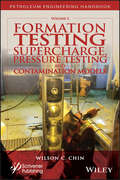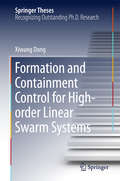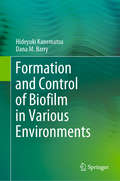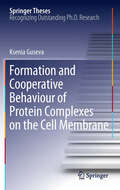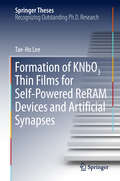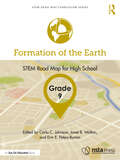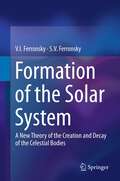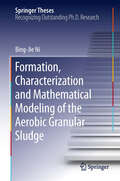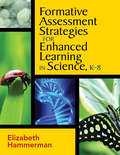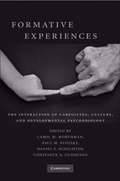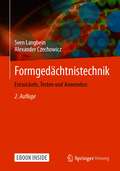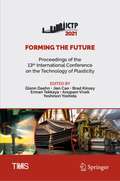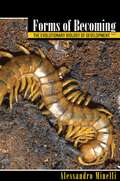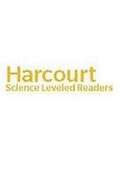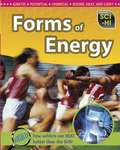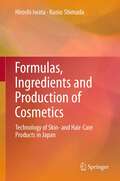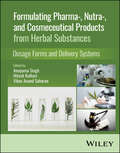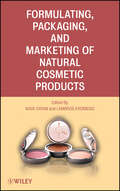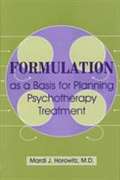- Table View
- List View
Formation Testing: Supercharge, Pressure Testing, and Contamination Models (Advances in Petroleum Engineering)
by Wilson C. ChinThis third volume in the “Formation Testing” series further develops new methods and processes that are being developed in the oil and gas industry. In the 1990s through 2000s, the author co-developed Halliburton’s commercially successful GeoTapTM real-time LWD/MWD method for formation testing, and also a parallel method used by China Oilfield Services, which enabled the use of data taken at early times, in low mobility and large flowline volume environments, to support the important estimation of mobility, compressibility and pore pressure, which are necessary for flow economics and fluid contact boundaries analyses (this work was later extended through two Department of Energy Small Business Innovation Research awards). While extremely significant, the effect of high pressures in the borehole could not be fully accounted for – the formation tester measures a combination of reservoir and mud pressure and cannot ascertain how much is attributed to unimportant borehole effects. The usual approach is “simply wait” until the effects dissipate, which may require hours – which imply high drilling and logging costs, plus increased risks in safety and tool loss. The author has now modeled this “supercharge” effect and developed a powerful mathematical algorithm that fully accounts to mud interations. In short, accurate predictions for mobility, compressibility and pore pressure can now be undertaken immediately after an interval is drilled without waiting. This groundbreaking new work is a must-have for any petroleum, reservoir, or mud engineer working in the industry, solving day-to-day problems that he or she encounters in the field.
Formation Tracking Control for Heterogeneous Swarm Systems
by Xiwang Dong Yongzhao Hua Zhang RenSwarm system, also known as multi-agent system, refers to a system composed of multiple subsystems (agents) with certain communication, calculation, decision-making, and action capabilities through local information interaction, such as a group of unmanned aerial vehicles (UAVs), unmanned ground vehicles (UGVs), satellites, etc. Formation tracking control of swarm systems is an important technical support and approach for the emergence of swarm intelligence at motion control level. By applying formation tracking control, swarm system agents can adjust their relations in the state or output space through neighboring information interaction, and then the swarm system can achieve favorable space-time conditions for many cooperative tasks such as source seeking, target enclosing, and surveillance. Thus, complex missions can be performed efficiently or cost-effectively. In cross-domain collaborative applications, including air-ground coordination and air-sea coordination, swarm systems are usually composed of several heterogeneous agents, and swarm intelligence can be enhanced by complementary functions of different agents. How to achieve time-varying formation tracking for heterogeneous swarm systems is crucial for cross-domain coordination, which has important theoretical value and practical significance. This important book presents a systematic theoretical approach and control framework on the time-varying formation tracking for high-order heterogeneous swarm systems. Distributed controller design and stability analysis of closed-loop systems for several specific formation tracking problems are provided. Furthermore, the proposed control approaches are applied to practical cooperative experiment platforms composed of UAVs and UGVs, and several formation tracking experiments are carried out to further verify the effectiveness of the theories.
Formation and Containment Control for High-order Linear Swarm Systems
by Xiwang DongThis book focuses on analysis and design problems for high-order linear time-invariant (LTI) swarm systems (multi-agent systems) to achieve consensus, formation, containment and formation-containment. As a first step, the concepts of practical consensus and formation-containment are introduced. Unlike previous research, the formation in this book can be time-varying. A general framework for consensus, consensus tracking, formation, containment and state formation-containment is presented for the first time. Sufficient/necessary and sufficient conditions, and approaches to designing the protocols for swarm systems to achieve these control objectives, are respectively proposed. Autonomous time-varying formation experiments using five quadrotor unmanned aerial vehicles (UAVs) are conducted in an outdoor setting to demonstrate the theoretical results.
Formation and Control of Biofilm in Various Environments
by Hideyuki Kanematsu Dana M. BarryThis book provides excellent techniques for detecting and evaluating biofilms: sticky films on materials that are formed by bacterial activity and produce a range of industrial and medical problems such as corrosion, sanitary problems, and infections. Accordingly, it is essential to control biofilms and to establish appropriate countermeasures, from both industrial and medical viewpoints. This book offers valuable, detailed information on these countermeasures. It also discusses the fundamentals of biofilms, relates various substrates to biofilms, and presents a variety of biofilm reactors. However, the most important feature of this book (unlike others on the market) is its clear focus on addressing the practical aspects from an engineering viewpoint. Therefore, it offers an excellent practical guide for engineers and researchers in various fields, and can also be used as a great academic textbook.
Formation and Cooperative Behaviour of Protein Complexes on the Cell Membrane
by Ksenia GusevaWith the aim of providing a deeper insight into possible mechanisms of biological self-organization, this thesis presents new approaches to describe the process of self-assembly and the impact of spatial organization on the function of membrane proteins, from a statistical physics point of view. It focuses on three important scenarios: the assembly of membrane proteins, the collective response of mechanosensitive channels and the function of the twin arginine translocation (Tat) system. Using methods from equilibrium and non-equilibrium statistical mechanics, general conclusions were drawn that demonstrate the importance of the protein-protein interactions. Namely, in the first part a general aggregation dynamics model is formulated, and used to show that fragmentation crucially affects the efficiency of the self-assembly process of proteins. In the second part, by mapping the membrane-mediated forces into a simplified many-body system, the dynamic and equilibrium behaviour of interacting mechanosensitive channels is derived, showing that protein agglomeration strongly impacts its desired function. The final part develops a model that incorporates both the agglomeration and transport function of the Tat system, thereby providing a comprehensive description of this self-organizing process.
Formation and Evolution of Star-Forming Filaments in Molecular Clouds (Springer Theses)
by Daisei AbeThis book clears up some confusion in the field of star formation and proposes a solution to a problem that remains unsolved for more than a decade. Observations of molecular clouds show that dense filaments are the sites of present-day star formation, and it is thus necessary to understand the filament formation process because the filament is an initial condition in a star formation process. Theoretical studies suggest that shock waves in molecular clouds trigger filament formation. Several different mechanisms have been proposed, and the formation mechanism of the observed star-forming filaments is expected to be clarified. In this book, the author performs a series of isothermal magnetohydrodynamics (MHD) simulations of filament formation and identifies the formation mechanisms. It is found that the dominant filament formation mode changes with the velocity of the shock waves that trigger the filament formation. The filament width plays an important role in determining the fragmentation scale by self-gravity, and observations show that the width 0.1 pc is universal. On the other hand, in theory the width of the supercritical filaments was considered to be narrowed by self-gravity. Recent studies suggest that massive filaments are bound by the slow shocks that are caused by accretion flows onto the filaments. Since the wavefront of such a slow shock is known to be unstable as a slow shock instability (SSI), the accretion ram pressure is expected to be converted into thermal/turbulent pressure across the shock front, which potentially maintains the width. In the scale of dense filaments, ambipolar diffusion (AD) suppresses the SSI at small scales. The influence of AD on SSI is investigated using two-dimensional MHD simulations, and the nonlinear evolution of the SSI with AD is found to drive turbulences. The book demonstrate the effect of SSI including AD onto the filament evolution.
Formation and Temperature Stability of the Liquid Phase in Thin-Film Systems
by Serhii Dukarov Serhii Petrushenko Sergiy Bogatyrenko Vladimir SukhovThis book presents a summary of the topic of supercooling during crystallization in condensed films. While recent findings are mainly published in English, the foundational classical results were originally published in Russian, with limited accessibility to general readers. The present work is based on a 2019 Ukrainian monograph, "Temperature Stability of the Supercooled Liquid Phase in Condensed Films," which has been extensively revised and expanded.The book includes a detailed analysis of the thermodynamics of supercooled fluids, with updated and expanded sections. Additionally, new results on the supercooling of indium-lead (In-Pb) alloys in contact with amorphous molybdenum and fusible metals in contact with nanocrystalline layers are presented. These layers occupy a middle ground between amorphous (carbon, molybdenum, as-deposited germanium films) and polycrystalline (copper, silver, aluminum) substrates. The book gives particular attention to the peculiarities of contracted geometry conditions, which are natural for multilayered structures and can occur through fusible component segregation at grain boundaries.The analysis of new data has prompted a rethinking of the role of the more refractory layer's microstructure on the crystallization processes of metastable melts. The book includes a thorough discussion of these findings, highlighting the crucial role of the microstructure in the crystallization process. This book is a valuable resource for researchers and students interested in crystallization in thin-film metallic systems. This comprehensive study provides a detailed and authoritative analysis of the thermodynamics of supercooled fluids, and the impact of microstructure on the crystallization processes of metastable melts, making it an essential addition to any academic library.
Formation of KNbO3 Thin Films for Self-Powered ReRAM Devices and Artificial Synapses (Springer Theses)
by Tae-Ho LeeThis thesis describes an investigation into homogeneous KN crystalline films grown on Pt/Ti/SiO2/Si substrates, amorphous KN films grown on TiN/Si substrates using the RF-sputtering method, and the ferroelectic and piezoelectric properties of these KN films. KNbO3 (KN) thin films have been extensively investigated for applications in nonlinear optical, electro-optical and piezoelectric devices. However, the electrical properties of KN films have not yet been reported, because it is difficult to grow stoichiometric KN thin films due to K2O evaporation during growth. This thesis also reports on the ReRAM properties of a biocompatible KN ReRAM memristor powered by the KN nanogenerator, and finally shows the biological synaptic properties of the KN memristor for application to the artificial synapse of a neuromorphic computing system.
Formation of the Earth, Grade 9: STEM Road Map for High School (STEM Road Map Curriculum Series)
by Carla C. Johnson Erin E. Peters-Burton Janet B. WaltonWhat if you could challenge your ninth graders to use geologic theory and standards of measurement to explore different epochs and time periods of the Earth’s formation? With this volume in the STEM Road Map Curriculum Series, you can! Formation of the Earth outlines a journey that will steer your students toward authentic problem solving while grounding them in integrated STEM disciplines. Like the other volumes in the series, this book is designed to meet the growing need to infuse real-world learning into K–12 classrooms. This interdisciplinary, three-lesson module uses project- and problem-based learning to help students investigate how Earth science professionals gather information and develop theories about the formation of the Earth and the processes taking place since the proliferation of humans. Working in teams, students will work to identify, define and describe the attributes scientists use to delineate Earth’s eras, periods, and epochs, in order to determine the appropriate boundary event to define the Anthropocene Epoch, and will develop a publication-ready textbook entry for an Earth science textbook. To support this goal, students will do the following: • Identify, define, and describe attributes of eras, periods, and epochs which have marked geologic time in Earth’s history. • Evaluate various possible index layers and boundary events that mark the beginning of the Anthropocene Epoch to determine which is most appropriate when labeling the current epoch in Earth’s history. • Design and present a multimedia presentation to share with textbook publishers regarding information on the Anthropocene Epoch, to include in a secondary-level Earth science textbook. • Create a publication-ready textbook entry describing the Anthropocene Epoch. The STEM Road Map Curriculum Series is anchored in the Next Generation Science Standards, the Common Core State Standards, and the Framework for 21st Century Learning. In-depth and flexible, Formation of the Earth can be used as a whole unit or in part to meet the needs of districts, schools, and teachers who are charting a course toward an integrated STEM approach.
Formation of the Solar System
by S. V. Ferronsky V. I. FerronskyAnalysis of the orbital motion of the Earth, the Moon and other planets and their satellites led to the discovery that all bodies in the Solar System are moving with the first cosmic velocity of their proto parents. The mean orbital velocity of each planet is equal to the first cosmic velocity of the Protosun, the radius of which is equal to the semi-major axis of the planet's orbit. The same applies for the planets' satellites. All the small planets, comets, other bodies and the Sun itself follow this law, a finding that has also been proven by astronomical observations. The theoretical solutions based on the Jacobi dynamics explain the process of the system creation and decay, as well as the nature of Kepler's laws.
Formation, characterization and mathematical modeling of the aerobic granular sludge
by Bing-Jie NiAerobic granular sludge technology will play an important role as an innovative technology alternative to the present activated sludge process in industrial and municipal wastewater treatment in the near future. Intended to fill the gaps in the studies of aerobic granular sludge, this thesis comprehensively investigates the formation, characterization and mathematical modeling of aerobic granular sludge, through integrating the process engineering tools and advanced molecular microbiology. The research results of this thesis contributed significantly to the advance of understanding and optimization of the bacterial granulation processes, the next generation of technology for cost-effective biological wastewater treatment. Dr. Bing-Jie Ni works at Advanced Water Management Centre (AWMC) of The University of Queensland, Australia.
Formative Assessment Strategies for Enhanced Learning in Science, K-8
by Elizabeth HammermanUse formative assessment to guide successful teaching and learning in science! Outlining the formative assessment process and providing strategies for embedding assessment into the K–8 standards-based science curriculum, this essential resource demonstrates how teachers can use formative assessments to modify instruction, monitor student progress, and evaluate learning. This user-friendly guide offers teachers discussions, reflection activities, and classroom strategies to: Assess student understanding using observation checklists, questioning strategies, notebooks, reports, graphic organizers, projects, and performance tasks Differentiate science instruction to reach all learners Use rubrics to uncover student strengths and weaknesses Collect student data to inform instructional decisions
Formative Experiences: The Interaction of Caregiving, Culture, and Developmental Psychobiology
by Carol M. Worthman Paul M. Plotsky Daniel S. Schechter Constance A. CummingsThe authors offer a unique exploration of the formative effects of children's early life experiences, with an emphasis on interactions among neurodevelopmental, behavioural, and cultural dynamics. Multidisciplinary case studies focus on specific periods of development, or windows of susceptibility, during which care giving and other cultural practices potentially have a long-lasting impact on brain and behaviour. Chapters describe in detail: how social experience interacts with neurodevelopmental disorders; how epigenetic mechanisms mediate the effects of early environment; the interaction of temperament and environmental influences; the implications of early life stress or trauma for mental health and well-being; and the cultural shaping of sexual development and gender identity. The final section translates insights from this work into a fresh appraisal of child-rearing practices, clinical interventions, and global public health policy that affect the mental health and well-being of children around the world.
Formatting Religion: Across Politics, Education, Media, and Law (Ethics, Human Rights and Global Political Thought)
by Marius Timmann MjaalandTo talk about religion is to talk about politics, identity, terrorism, migration, gender, and a host of other aspects of society. This volume examines and engages with larger debates around religion and proposes a new approach that moves beyond the usual binaries to analyse its role in our societies at large. Formatting Religion delves into these complexities and demonstrates the topical need for better understanding of how religion, society, culture, and law interact and are mutually influenced in periods of transition. It examines how over the last two decades, people and institutions have been grappling with the role of religion in socio-cultural and political conflicts worldwide. Drawing on a host of disciplines – including sociology, philosophy, anthropology, politics, media, law, and theology – the essays in this book analyse how religion is formatted today, and how religion continuously formats society, from above and from below. The volume will be of great interest to scholars and researchers of religious studies, politics, media and culture studies, and sociology.
Formgedächtnistechnik: Entwickeln, Testen und Anwenden
by Alexander Czechowicz Sven LangbeinTrotz der technischen Vorteile von Formgedächtnislegierungen (FGL) gegenüber den auf dem Markt befindlichen Lösungen, lässt der Durchbruch dieser Technologie noch immer auf sich warten. Dies liegt vor allem am mangelnden Konstruktionswissen bei industriellen Anwendern. Dieser Problematik soll dieses Buch mit Konstruktionsrichtlinien und Produktentwicklungsmethoden entgegentreten. Es werden von den Grundlagen über Auslegungsmethodiken bis hin zu Steuer- und Regelkreisen alle für den Produktentwickler wichtigen Aspekte beschrieben.
Forming the Future: Proceedings of the 13th International Conference on the Technology of Plasticity (The Minerals, Metals & Materials Series)
by Jian Cao Glenn Daehn Brad Kinsey Erman Tekkaya Anupam Vivek Yoshinori YoshidaIn this collection, scientists and engineers from across industry, academia, and government present their latest improvements and innovations in all aspects of metal forming science and technology, with the intent of facilitating linkages and collaborations among these groups. Chapters cover the breadth of metal forming topics, from fundamental science to industrial application.
Forms of Becoming: The Evolutionary Biology of Development
by Alessandro MinelliWhat comes first, form or function? Trumpeted as the future of biological science, evolutionary developmental biology (or "evo-devo") answers this fundamental question by showing how evolution controls the development of organisms. In Forms of Becoming, Alessandro Minelli, a leading international figure in the field, takes an in-depth and comprehensive look at the history and key issues of evo-devo. Spirited and insightful, this book focuses on the innovative ways animal organisms evolve through competition and cooperation. Minelli provides a complete overview of conceptual developments--from the fierce nineteenth-century debates between the French biologists Geoffroy and Cuvier, who fought over questions of form versus function--to modern theories of how genes dictate body formation. The book's wide-ranging topics include expression patterns of genes, developmental bias, the role of developmental genes, and genetic determinism. Drawing from diverse examples, such as the anatomy of butterflies, giraffes, Siamese twins, and corals, Minelli extends and reformulates important concepts from development, evolution, and the interplay between the two. Presenting the accessible and cutting-edge ideas of evolutionary developmental biology, Forms of Becoming is fascinating reading for anyone interested in genetics and the animal form.
Forms of Energy (Sci-hi: Physical Science Ser. #4)
by Anna Claybourne Heinemann StaffHigh-interest magazine-like design and approach that teaches science with clear introductions and content.
Formulas, Ingredients and Production of Cosmetics
by Hiroshi Iwata Kunio ShimadaToday, young cosmetics researchers who have completed their graduate studies and have entered a cosmetics company are put through several years of training before they become qualified to design cosmetics formulations themselves. They are trained so that they can design formulas not by a process of logic but by heart, like craftsmen, chefs, or carpenters. This kind of training seems a terrible waste of labor and time. To address this issue and allow young scientists to design novel cosmetics formulations, effectively bringing greater diversity of innovation to the industry, this book provides a key set of skills and the knowledge necessary for such pursuits. The volume provides the comprehensive knowledge and instruction necessary for researchers to design and create cosmetics products. The book's chapters cover a comprehensive list of topics, which include, among others, the basics of cosmetics, such as the raw materials of cosmetics and their application; practical techniques and technologies for designing and manufacturing cosmetics, as well as theoretical knowledge; emulsification; sensory evaluations of cosmetic ingredients; and how to create products such as soap-based cleansers, shampoos, conditioners, creams, and others. The potential for innovation is great in Japan's cosmetics industry. This book expresses the hope that the high level of dedicated research continues and proliferates, especially among those who are innovators at heart.
Formulating Pharma-, Nutra-, and Cosmeceutical Products from Herbal Substances: Dosage Forms and Delivery Systems
by Anupama Singh Vikas Anand Saharan Hitesh KulhariA practical and up-to-date discussion of the formulation and design of dosage forms and delivery systems containing herbal ingredients In Formulating Pharma-, Nutra-, and Cosmeceutical Products from Herbal Substances: Dosage Forms and Delivery Systems, a team of distinguished researchers delivers a step-by-step approach to preparing and manufacturing dosage forms and delivery systems. Intuitively organized with comprehensive coverage of the fundamentals, functional materials, manufacturing, and marketing of pharmaceutical, nutraceutical, and cosmeceutical products, the book also examines regulatory issues of quality, safety, and efficacy. The authors discuss essential formulation development and delivery information for novel and controlled delivery systems of herbal ingredients. Readers will also find: A thorough introduction to the basic principles of developing modern pharma-, nutra-, and cosmeceutical products from herbal substancesComprehensive explorations of conventional formulations, including issues of stabilityPractical discussions of advanced formulations, including chronotherapeutic delivery systems, liposome-based delivery of phytoconstituents, and nanoparticle mediated delivery of herbal activesComplete treatments of regulatory challenges, including nonclinical characterization and documentation for marketing authorizations of herbal formulations Perfect for professionals working in the herbal drug, natural product, and dietary supplement industries, Formulating Pharma-, Nutra-, and Cosmeceutical Products from Herbal Substances will also benefit academic researchers and graduate students studying herbal research, cosmetics, and pharmaceutical sciences.
Formulating Poorly Water Soluble Drugs (AAPS Advances in the Pharmaceutical Sciences Series #50)
by Robert O. Williams III Dave A. Miller Daniel A. Davis Jr.The objective of this third edition is to consolidate within a single text the most current knowledge, practical methods, and regulatory considerations pertaining to formulations development with poorly water-soluble molecules. A pharmaceutical scientist’s approach toward solubility enhancement of a poorly water-soluble molecule typically includes detailed characterization of the compound’s physiochemical properties, solid-state modifications, advanced formulation design, non-conventional process technologies, advanced analytical characterization, and specialized product performance analysis techniques. The scientist must also be aware of the unique regulatory considerations pertaining to the non-conventional approaches often utilized for poorly water-soluble drugs. One faced with the challenge of developing a drug product from a poorly soluble compound must possess at a minimum a working knowledge of each of the above mentioned facets and detailed knowledge of most. In light of the magnitude of the growing solubility problem to drug development, this is a significant burden especially when considering that knowledge in most of these areas is relatively new and continues to develop.
Formulating, Packaging, and Marketing of Natural Cosmetic Products
by Nava Dayan Lambros KromidasBalanced coverage of natural cosmetics, and what it really means to be "green"The use of natural ingredients and functional botanical compounds in cosmetic products is on the rise. According to industry estimates, sales of natural personal care products have exceeded $7 billion in recent years. Nonetheless, many misconceptions about natural products-for instance, what "green" and "organic" really mean-continue to exist within the industry. Formulating, Packaging, and Marketing of Natural Cosmetic Products addresses this confusion head-on, exploring and detailing the sources, processing, safety, efficacy, stability, and formulation aspects of natural compounds in cosmetic and personal care products. Designed to provide industry professionals and natural product development experts with the essential perspective and market information needed to develop truly "green" cosmetics, the book covers timely issues like biodegradable packaging and the potential microbial risks they present, the use of Nuclear Magnetic Resonance (NMR) to identify biomarkers, and chromatographic methods of analyzing natural products. A must-read for industry insiders, Formulating, Packaging, and Marketing of Natural Cosmetic Products provides the reader with basic tools and concepts to develop naturally derived formulas.
Formulation As A Basis For Planning Psychotherapy Treatment
by Mardi J. HorowitzTo help their patients, clinicians must make accurate diagnoses and devise effective treatment plans. These plans often involve psychotherapy with goals that include symptom reduction, the prevention of relapse, and helping patients recognize and remove impediments to more effective functioning. Formulation as a Basis for Planning Psychotherapy Treatment presents a formulation system that combines concepts derived from psychodynamic, interpersonal, cognitive-behavioral, and family system approaches. In a step-by-step manner, illustrated by plentiful case examples, this useful guide shows psychiatrists, residents in psychiatry and psychology, social workers, and marriage and family counselors how to plan treatment after the initial diagnosis. After an overview of psychological change processes, each of the five steps in the formulation process are covered systematically. Case formulation is begun by the careful selection and description of a patient's symptoms and problems. This information is then grouped into states of mind, an approach that allows for multiple presentations of a patient, avoids static descriptions of observations, and places many observable features into meaningful clusters of co-occurrence. Subsequent chapters explain how all of this information can be used to focus the treatment and identify defensive controls that may interfere with treatment. The author describes how to infer deep beliefs about the self in terms of views of relationships with others. The book teaches how to formulate plans for interventions during psychotherapy.
Formulation of Disperse Systems
by Tharwat F. TadrosThis book presents comprehensively the science and technology behind the formulation of disperse systems like emulsions, suspensions, foams and others. Starting with a general introduction, the book covers a broad range of topics like the role of different classes of surfactants, stability of disperse systems, formulation of different dispersions, evaluation of formulations and many more. Many examples are included, too. Written by the experienced author and editor Tharwart Tadros, this book is indispensable for every scientist working in the field.
